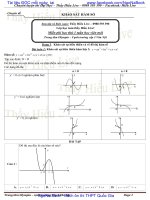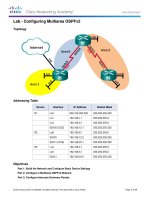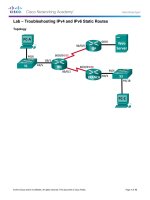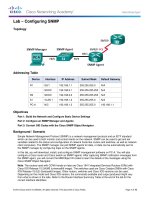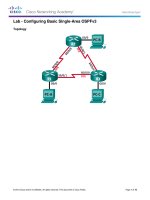en route v6 ch02 pptx 5999 kho tài liệu bách khoa
Bạn đang xem bản rút gọn của tài liệu. Xem và tải ngay bản đầy đủ của tài liệu tại đây (2.24 MB, 175 trang )
Chapter 2:
Configuring the Enhanced
Interior Gateway Routing
Protocol
CCNP ROUTE: Implementing IP Routing
ROUTE v6 Chapter 2
© 2007 – 2010, Cisco Systems, Inc. All rights reserved.
Cisco Public
1
Chapter 2 Objectives
Describe the basic operation of EIGRP.
Plan and implement EIGRP routing.
Configure and verify EIGRP routing.
Configure and verify basic EIGRP in an enterprise WAN.
Configure and verify EIGRP Authentication.
Describe and configure EIGRP optimization mechanisms;
verify and troubleshoot the overall implementation.
Chapter 2
© 2007 – 2010, Cisco Systems, Inc. All rights reserved.
Cisco Public
2
Understanding
EIGRP
Terminology
and Operation
Chapter 2
© 2007 – 2010, Cisco Systems, Inc. All rights reserved.
Cisco Public
3
EIGRP Capabilities and Attributes
EIGRP is a Cisco-proprietary distance-vector protocol with
link-state features.
EIGRP features include:
•
•
•
•
•
•
Fast convergence
Partial updates
Multiple network layer support
Use of multicast and unicast communication
Variable-length subnet masking (VLSM) support
Seamless connectivity across all data link layer protocols and
topologies
• By default, it performs automatic route summarization at major
network boundaries (can be disabled) but can also be configured to
summarize on interfaces.
Chapter 2
© 2007 – 2010, Cisco Systems, Inc. All rights reserved.
Cisco Public
4
EIGRP Terminology
Neighbor table
Topology table
Routing table
Advertised Distance (AD)
Feasible Distance (FD)
Successor
Feasible successor (FS)
Passive Versus Active Routes
Chapter 2
© 2007 – 2010, Cisco Systems, Inc. All rights reserved.
Cisco Public
5
EIGRP Tables
Neighbor table
• Contains EIGRP neighbor addresses and the interface through which
they can be reached.
Topology table
• Contains all destinations advertised by neighboring routers.
Routing table
• Contains EIGRP successor routes.
Chapter 2
© 2007 – 2010, Cisco Systems, Inc. All rights reserved.
Cisco Public
6
AD versus FD
Advertised Distance (AD)
• Advertised distance (AD), also referred to as the Reported Distance,
is the cost between the next-hop router and the destination.
Feasible Distance (FD)
• Feasible distance (FD) is the cost between the local router and the
next-hop router plus the next-hop router’s AD to the destination
network.
Chapter 2
© 2007 – 2010, Cisco Systems, Inc. All rights reserved.
Cisco Public
7
Successor and Feasible Successor
Successor
• A successor is a neighboring router that has a least-cost path to a
destination (the lowest FD) that is guaranteed not to be part of a routing
loop.
• Successor routes are offered to the routing table to be used for
forwarding packets.
• Multiple successors can exist if they have the same FD.
Feasible successor (FS)
• A feasible successor is a neighbor that is closer to the destination, but it
is not the least-cost path.
• A feasible successor ensures a loop-free topology because it must have
an AD less than the FD of the current successor route.
• Feasible successors are selected at the same time as successors but are
kept in the topology table as backups to the successor routes.
• The topology table can maintain multiple feasible successors for a
destination.
Chapter 2
© 2007 – 2010, Cisco Systems, Inc. All rights reserved.
Cisco Public
8
Passive versus Active Routes
Passive Route
• A route is considered passive when the router is not performing
recomputation on that route.
• Passive is the operational, stable state.
Active route
• A route is active when it is undergoing recomputation.
Chapter 2
© 2007 – 2010, Cisco Systems, Inc. All rights reserved.
Cisco Public
9
Key EIGRP Technologies
Reliable Transport Protocol (RTP)
• Responsible for guaranteed, ordered delivery of EIGRP packets to all
neighbors.
Neighbor discovery/recovery mechanism
• Enables EIGRP routers to dynamically learn when their neighbors
become unreachable or inoperative by periodically sending small hello
packets.
Protocol-dependent modules (PDMs)
• Responsible for network layer protocol-specific requirements such as IP,
IPv6, AppleTalk, and Novell NetWare.
DUAL finite-state machine
• Diffusing Update Algorithm (DUAL) is the routing algorithm that tracks
all routes advertised by all neighbors and uses distance information,
known as the composite metric, to select efficient, loop-free paths to all
destinations.
Chapter 2
© 2007 – 2010, Cisco Systems, Inc. All rights reserved.
Cisco Public
10
Reliable Transport Protocol
EIGRP cannot use the services of UDP or TCP since IPX
and Appletalk do not use the TCP/IP protocol suite.
Reliable Transport Protocol (RTP) is the Transport layer
protocol uniquely used by EIGRP for the delivery and
reception of EIGRP packets.
• RTP is similar to TCP but is a Cisco proprietary.
RTP provides reliable or unreliable service as the situation
warrants.
• Reliable packets (Update, Query, Reply) require explicit
acknowledgement while unreliable packets (Hello, ACK) do not.
Chapter 2
© 2007 – 2010, Cisco Systems, Inc. All rights reserved.
Cisco Public
11
Neighbor Discovery / Recovery
EIGRP routers actively establish relationships with their
neighbors.
Adjacencies are established using small Hello packets
which are sent every 5 or 60 seconds.
• If a neighbor misses 3 consecutive Hello packets then the route is
considered invalid.
• Default = 15 seconds or 180 seconds.
Chapter 2
© 2007 – 2010, Cisco Systems, Inc. All rights reserved.
Cisco Public
12
Neighbor Discovery / Recovery
Chapter 2
© 2007 – 2010, Cisco Systems, Inc. All rights reserved.
Cisco Public
13
Protocol-Dependent Modules
Various routed protocols are supported through its PDMs.
•
•
•
•
Provides independence from routed protocols.
PDMs are modular, scalable and adaptable.
EIGRP can adapt to new or revised routed protocols.
PDMs protect EIGRP from painstaking revision.
Each PDM is responsible for all functions related to its
specific routed protocol.
Chapter 2
© 2007 – 2010, Cisco Systems, Inc. All rights reserved.
Cisco Public
14
Protocol-Dependent Modules
EIGRP maintains
individual tables for
each routed protocol.
Chapter 2
© 2007 – 2010, Cisco Systems, Inc. All rights reserved.
Cisco Public
15
DUAL finite-state machine
DUAL uses the Neighbor and Topology tables to calculate
route information.
When a link fails, DUAL looks for a feasible successor in its
Neighbor and Topology tables.
• It compares all routes advertised by neighbors by using a composite
metric for each route.
• Lowest-cost paths are then inserted into the routing table.
Chapter 2
© 2007 – 2010, Cisco Systems, Inc. All rights reserved.
Cisco Public
16
EIGRP Packet
Frame Payload
Frame Header
On a LAN, the EIGRP
packet is encapsulated
in an Ethernet frame
with a destination
multicast MAC address:
IP
Header
Protocol Number
(EIGRP = 88)
The destination IP address is
set to the multicast 224.0.0.10
and the EIGRP protocol field
is 88.
EIGRP
Header
The EIGRP
header identifies
the type of EIGRP
packet and
autonomous
system number.
EIGRP
Message
CRC
The EIGRP
message
consists of
the Type /
Length /
Value (TLV).
01-00-5E-00-00-0A
Chapter 2
© 2007 – 2010, Cisco Systems, Inc. All rights reserved.
Cisco Public
17
EIGRP Header
EIGRP uses these 5 packet types to maintain its various
tables and establish complex relationships with neighbor
routers:
•
•
•
•
•
Hello
Acknowledgment
Update
Query
Reply
Chapter 2
© 2007 – 2010, Cisco Systems, Inc. All rights reserved.
Cisco Public
18
EIGRP Header
Chapter 2
© 2007 – 2010, Cisco Systems, Inc. All rights reserved.
Cisco Public
19
EIGRP Packet
Chapter 2
© 2007 – 2010, Cisco Systems, Inc. All rights reserved.
Cisco Public
20
Hello Packets
EIGRP relies on Hello packets to discover, verify, and
rediscover neighbor routers.
EIGRP Hello packets are multicast to 224.0.0.10.
Hello packets are always sent unreliably and therefore do
not require acknowledgment.
Chapter 2
© 2007 – 2010, Cisco Systems, Inc. All rights reserved.
Cisco Public
21
EIGRP Hello Packets
Chapter 2
© 2007 – 2010, Cisco Systems, Inc. All rights reserved.
Cisco Public
22
Hello Packets
Hellos are sent at a fixed (and configurable) interval, called
the Hello interval.
• Hello/Hold timers do not need to match.
• To reset the Hello interval: no ip hello-interval eigrp as#
Hello interval depends on the interface’s bandwidth.
• High bandwidth = 5 seconds
• Default interval on point-to-point serial links, multipoint circuits with
bandwidth greater than T1, and LANs.
• Low Bandwidth = 60 seconds
• Default interval on T1 or less multipoint WAN circuits.
Chapter 2
© 2007 – 2010, Cisco Systems, Inc. All rights reserved.
Cisco Public
23
Hello Packets
On hearing Hellos, a router creates a neighbor table and
the continued receipt of Hellos maintains the table.
Holdtime is the maximum amount of allowed time that
Hellos are not heard from a neighbor.
• Three times the Hello Interval:
• Low Bandwidth (3 x 60 sec.)
= 180 seconds
• High bandwidth (3 x 5 sec.)
= 15 seconds
Chapter 2
© 2007 – 2010, Cisco Systems, Inc. All rights reserved.
Cisco Public
24
Hello Packets
T3
Chapter 2
© 2007 – 2010, Cisco Systems, Inc. All rights reserved.
Cisco Public
25


